
The company liquidation process often creates complex tax implications, especially regarding the treatment of remaining debts to shareholders. This is reflected in the dispute between PT SG and the Directorate General of Taxes (DJP) concerning the 2021 Tax Year. The dispute originated from a Corporate Income Tax correction of Rp. 10.05 billion, which DJP classified as income from debt forgiveness under Article 4 paragraph (1) letter k of the Income Tax Law.
The core conflict began when PT Sariposo Gemilang, which had ceased operations in 1998, held a General Meeting of Shareholders (GMS) for dissolution in April 2021. At that time, the company recorded a trade debt balance (owed to shareholders) of Rp. 11.21 billion. DJP argued that because the shareholders (creditors) did not file their claims within the timeframe stipulated by the Company Law, the debt was automatically considered forgiven. DJP calculated the gain from debt forgiveness by subtracting the total distributed remaining assets (Rp. 1.16 billion) from the total debt, resulting in the Rp. 10.05 billion correction.
PT SG rejected the correction with a multi-layered argument. From a civil law perspective, debt forgiveness cannot be assumed (Article 1438 Civil Code). From an accounting perspective (PSAK 23), debt forgiveness from a shareholder is a capital transaction, not income. Fiscally (Article 4 (1) Income Tax Law), PT SG asserted the absence of any "additional economic capability" received by a company undergoing dissolution.
The Tax Court Panel adopted comprehensive legal reasoning. The Panel agreed with DJP that the Company and its shareholders are separate legal entities, and that the event of debt forgiveness (fiscally) had occurred and was indeed a tax object. However, the Panel found a flaw in DJP's analysis: it failed to apply the comprehensive income principle as mandated by the Elucidation of Article 4 paragraph (1) of the Income Tax Law. This principle requires all income (including gains from debt forgiveness) to be horizontally compensated with all losses within the same tax year.
The Panel found that at the time of liquidation, PT SG had a negative equity (loss) of Rp. 17.21 billion. In its decision, the Panel ruled that the gain from debt forgiveness (Rp. 10.05 billion) must be combined with the liquidation loss (Rp. 17.21 billion). Because the loss exceeded the gain, the Panel concluded there was no net "additional economic capability" that could become Taxable Income. This decision affirms that while debt forgiveness during liquidation is a tax object, its taxability is absolutely dependent on a net (comprehensive) calculation against existing losses.
A Comprehensive Analysis and the Tax Court Decision on This Dispute Are Available Here